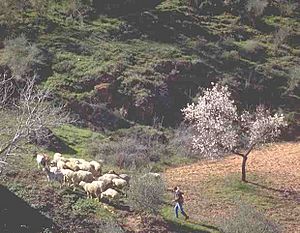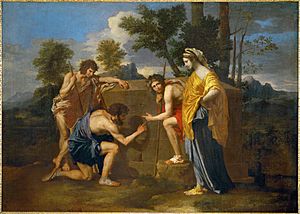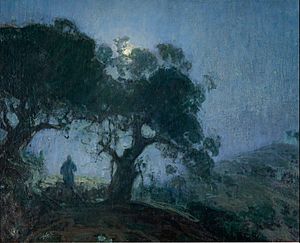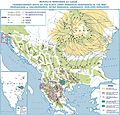Shepherd facts for kids
A shepherd is a person who takes care of sheep. Shepherds usually lead their sheep to fields so the sheep can eat grass. This is called grazing. Just like a shepherd looks after sheep, a "cowherd" looks after cows, a "swineherd" looks after pigs, and a "goatherd" looks after goats. A herd is a group of animals. "Herding" means guiding a group of animals from one place to another. A female shepherd is called a “shepherdess”.
Long ago, when most people lived in the countryside, being a shepherd was very common. People kept sheep for their milk, meat, and especially their soft wool. We know that shepherds have been around for thousands of years in many parts of the world. The main job of a shepherd was to keep the sheep safe. They had to protect them from wild animals like wolves that might try to eat them.
Contents
The Shepherd's Daily Life
In many societies, shepherds were a very important part of how people made a living. Unlike farmers who owned land, shepherds were often paid to look after other people's sheep. They were like employees. Shepherds often lived by themselves, sometimes moving from place to place with their sheep. These shepherds were called nomads. In some families, a child, a young person, or an older person who couldn't do harder farm work would be the family's shepherd.
Working with Sheepdogs
Shepherds often worked closely with dogs. These dogs, called sheepdogs, were specially trained to help guide the sheep. Even today, there are popular events called sheepdog trials. In these trials, the shepherd gives signals to the dog, telling it exactly where to move the sheep. It's amazing to watch how well they work together!
Shepherds and Music
Shepherds had a lot of quiet time while watching their sheep. They often used this time to think or to entertain themselves. Many shepherds made simple musical instruments from reeds that grew nearby. These instruments were often like small pan flutes or simple pipes, similar to bamboo pipes or a modern recorder. Some shepherds even learned to carve more complex instruments from wood, like the fujara from Slovakia and southern Poland.
Shepherds in Art and Stories
The peaceful life of a shepherd has inspired many artists and writers.
Music Inspired by Shepherds
Because shepherds often made their own music, many composers of classical music wrote pieces that sounded like a shepherd's pipe. For example, in Mozart’s opera The Magic Flute, a character named Papageno plays his pipes. In the Symphonie Fantastique, Hector Berlioz wrote music that sounds like a shepherd playing his pipes, with another shepherdess answering from far away. Berlioz used instruments like the oboe and cor anglais to create this sound.
Shepherds in Paintings and Poems
Musicians were not the only ones who loved the idea of a shepherd's life. Many painters created beautiful scenes of the countryside with shepherds looking after their sheep. Poets also wrote many poems about shepherds. This shepherd's way of life was often seen as a perfect, simple way to live. This idea was called Arcadian. Poems about shepherds and country life are called pastoral poems. Some very old examples include the Idylls by Theocritus and the Eclogues by Virgil.
Shepherds in Religion
Shepherds are important figures in several religions:
- King David, a famous king of Israel, was a shepherd before he became king.
- In the Christian religion, Jesus is often called “the good shepherd.” This is because he cares for his followers just like a shepherd cares for his sheep.
- Muhammad, the Prophet of Islam, was one of many prophets who worked as shepherds.
Related pages
Images for kids
-
Shepherd with grazing sheep in Făgăraș Mountains, Romania
-
Shepherds at work, 2017, Beskids, Carpathian Mountains
-
Transhumance ways of the Vlach shepherds in the past
-
Shepherd's watch box, New South Wales
-
Fifth-century Ravenna mosaic illustrating the concept of The Good Shepherd
-
A Sleeping Nymph Watched by a Shepherd by Angelica Kauffman, about 1780, V&A Museum no. 23-1886
-
Traditional midnight mass with shepherds in Provence














